Keyframe Control of Complex Particle Systems Using the Adjoint Method
1 / 20
Title:
Keyframe Control of Complex Particle Systems Using the Adjoint Method
Description:
Keyframe Control of Complex Particle Systems Using the Adjoint Method ... Adjoint method is theoretically sensitive to discontinuities ... –
Number of Views:68
Avg rating:3.0/5.0
Title: Keyframe Control of Complex Particle Systems Using the Adjoint Method
1
Keyframe Control of Complex Particle Systems
Using the Adjoint Method
- Chris Wojtan Peter J. Mucha Greg Turk
- ACM SIGGRAPH Symposium on Computer Animation 2006
2
Motivation
- Simulated animation is hard to control
- High level control is necessary
- Propose a way to control interacting particles by
keyframes - Flock
- Cloth
3
Related works
- Keyframe control simulation
- Interactive manipulation of rigid body simulation
Popovic et. al. SIGGRAPH 00 - Directable animation of elastic objects Kondo
R. et. al. SCA 05 - Keyframe control of smoke simulations Treuille
A. et. al. SIGGRAPH03 - Fluid control using the adjoint method McNamara
A. et. al. SIGGRAPH 04
4
Related works (cont.)
- Flocks
- Flocks, herds, and schools A distributed
behavioral model. Reynolds C. W. SIGGRAPH 87 - Cloth
- Large steps in cloth simulation. Baraff D.,
Witkin A. SIGGRAPH 98 - Stable but responsive cloth. Choi K. J., Ko H.
S. SIGGRAPH 02
5
Interactive particle system
- Each Particle has its own properties
- position, velocity, mass, etc.
- Particles may exert forces between each other
- External forces may exist
6
Keyframe matching
F0
F1
F2
Fn
Define the objective function
P0
P1
P2
Pn
n frame number qn state vector of keyframe Wn
Weights Cn Mapping from u to q a smoothness Q
aggregation of q0qN
State vector
Control vector
7
Problem of finding minimum
- Gradient-based method
- Expensive computation
- Dimension explosion in normal way
- Solve by the adjoint method!
8
Adjoint method
- Duality
- Given matrices A, C and vector g are known
- its adjoint vector, s
- It is exactly the same as the original one!
9
Adjoint method (cont.)
- Generally speaking, qi1 fi(qi)
- fi updating operation
- Simply apply external forces in this system
- f(q) q Mtu
- Suppose all the forces are applied linearly
- Mt matrix converting u to an incremental state
- Rewrite in a aggregate form
- Q F(Q,u)
10
Adjoint method (cont.)
gT
A
B
C
g
sT
A
11
Adjoint method (cont.)
- Solving for the adjoint vector
recall that qi1 fi(qi)
- Simply use Gaussian elimination
- Solve backward in time
A
12
Adjoint method (cont.)
- Workflow
- Huge memory consumption, but efficient.
13
Control flocking
- Control force
- Collision avoidance
- Velocity matching force
- Flocking centering force
- Wander force
- Solving by forward Euler scheme
14
Control flocking (cont.)
- Derivation
- F ?t V(Q) gt Qn1 ?t V(Qn)
- Resulting adjoint vector
15
Control flocking (cont.)
- Extending some constraints for more intuitive
control - Center of mass constraints
- Shape constraints
- No need to modify objective function
- Compute difference between boundary shape
- Computer difference between centers of mass
16
Control cloth
- A different story!
- Solving by backward Euler scheme
General form of its adjoint vector
?????(???)??
17
Control cloth (cont.)
- Dimension explosion!
- Expensive both in space and in time
- Avoid exact calculation, use approximation!
- Calculate adjoints of backward Euler to
approximate adjoints of linearized scheme
18
Control cloth (cont.)
- Derivation
- F ?t V(Qn1)
- Result adjoint
- Introduce O(?t3) errors
19
Results
- No benchmark, no spec of demo environmentjust
video!
20
Conclusion future work
- Efficient control of particle system
- Simple system like flocking
- Stiff system like cloth
- Main contribution!
- More robust cloth control
- Adjoint method is theoretically sensitive to
discontinuities - Large amount of collision detection cannot occur.































